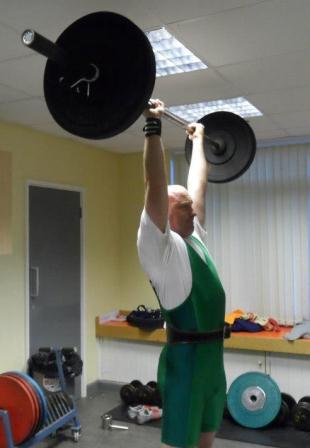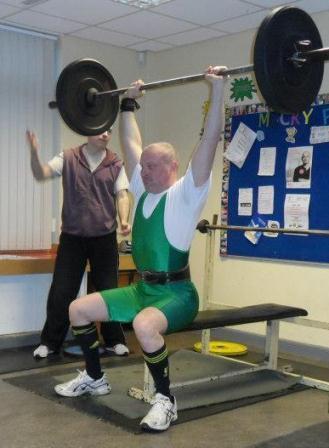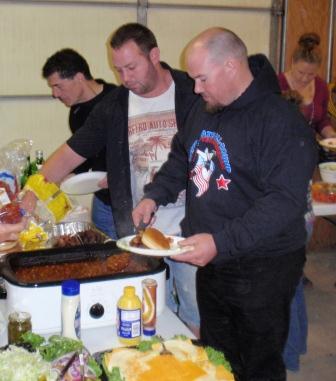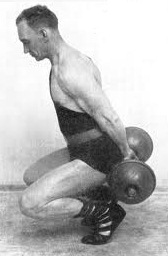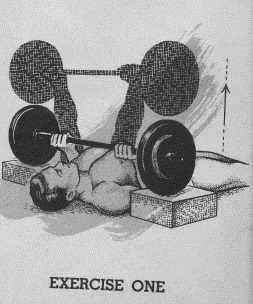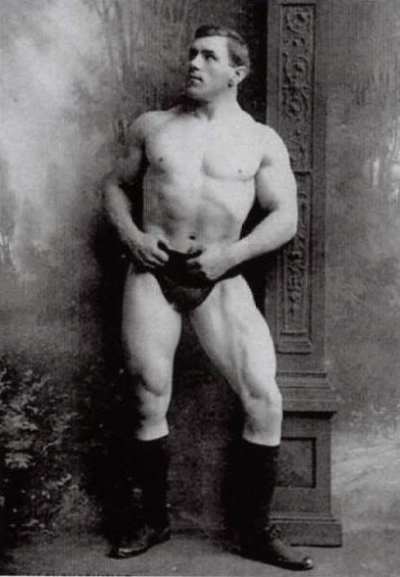Gary Ell – The Tiverton Dynamo
by Al Myers
Recently I had the great fortune of interviewing “The Tiverton Dynamo” Gary Ell. Gary lives in Tiverton, Devon, England. He trains at the Tiverton Weightlifting Club and has been competing at the IAWA World level for several years now. Gary is a very dynamic lifter – and recently performed a very exhausting lifting marathon as a fundraiser for hospice. Most don’t know this about Gary, but in March of 2007 he was in a serious car accident. As he was sitting in his stationary car, another vehicle going 70 mph smashed into the back of his car! The doctors said he would never walk right again, let alone ever lift! He has proved them all wrong. Initially all he could do is Bench Press as he suffered a serious back injury. The other guys in the club had to actually lift him off the bench after his sets since he couldn’t get off the bench by himself!!! Gradually, through persistent training he has been able to regain most of the lost strength. Gary has a lifting tenacity that few have – thus earning the nickname of the Tiverton Dynamo!! Last month I was able to “catch up” with Gary at the Gold Cup in Glasgow, Scotland – so let’s get to the interview!
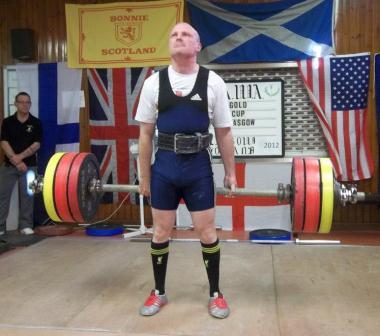
Gary Ell performing a 2" Bar Hack Lift of 185 kilograms at the 2012 IAWA Gold Cup in Glasgow, Scotland. This was the FIFTH BEST performance of the Gold Cup, based on the Blindt Formula.
AL: Please tell me a little about yourself. I have known you for a few years now, but I don’t know much about your personal life.
GARY: Al, I have been married to Jackie for 18 years (Jackie works in a bakery). I have one stepson Kris who is 22 and a chef, and 2 daughters Maddy (17) in the Royal marines band (saxophonist), and Mina (15) who is studying at high school. I worked previously as a brewery engineer and before that as a beer taster. For the past four years I have worked as an Ambulanceman. The other sport I play is Water Polo and I represent Tiverton playing in goal. I have played many sports over the years including cricket, soccer and rowing. My ‘weights’ career started in powerlifting, graduating into All-Round lifting for fresh challenges. I love the variety of lifts and never lack for a challenge, always encouraging the youths at the club to try new lifts. No two workouts of mine are ever the same!
AL: Recently, you performed an IAWA lift (Total P0undage Lift) that is not very well known for a charity cause. Could you elaborate on this? I’m interested in what motivated you to do this and why, as well as the specifics of your record setting effort.
GARY: I had decided to raise some money for charity (hospiscare – who look after cancer and other terminally ill patients). I visit the hospice and I know the nurses who provide great help and support in the community as well. 1 in 3 people get cancer during their lifetime, some survive and unfortunately some don’t make it. Having read Steve Gardner’s tribute to Andy Goddard (although I hadn’t met Andy), this cemented my plan to do something positive. Having found the Inman mile I persuaded the lads at the club to give it a go earlier in the year. I looked for a fitting challenge.
Then the F4 lift “total in 3hrs 9 mins” was discovered. I mentioned it at the club that I wanted to give it a go. After putting together the necessary helpers, refs, etc, Mark Rattenberry said why don’t you do a variety of lifts? And so the ‘Century Lift a thon’ was born, comprising of 100 different IAWA lifts to be completed in the time limit. I proceeded to construct a true all body list of the 100, incorporating Power, Dumbell, Olympic, Speciality(Steinborn, Zercher, Shoulder drop etc) and 2″ bar grip test as the lifts. All the lifts had to be unaided, no harnesses or equipment lifts. And all through just the hands. (the Travis was included, but executed with just hands and no special belt). The first challenge was to do the 100. The second challenge was to look at the masters records and list them all, to see if any were possible! The third challenge was to try and lift 15tons through the hands in the time.
And so the exhibition began, the lifts being done pretty much in order, no warm ups ,straight in , a blend of maximal lifting , repetitions, and speed lifts, one after the other (to catch up time). Pauses and more attempts for the records, some just done and moved on to the next. It became a battle of endurance and fatigue was a very big factor around the 2 hr mark. I’d left most of the deadlift style exercises to the end of the list, but only ended up with 1 rep straddle, hack and deadlift as the power had all gone. All 100 exercises were completed, totalling 400 successful lifts, and 36522.7kgs (80349.9lbs)
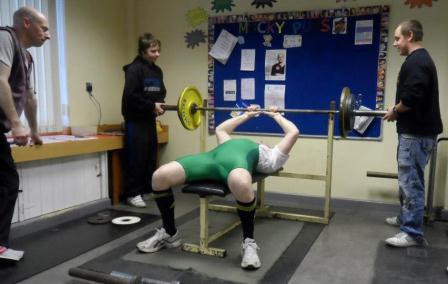
Gary performing a hands together bench press during the event. Gary did 100 different All-Round lifts during his record setting performance!
AL: That’s an amazing accomplishment! I’m sure you were pretty sore the next day! Surely, you had to have several helpers to make this effort happen? Also, I know you did this as a fundraiser. Did you met your goal?
GARY: Hands – Very sore, after the lifts I couldn’t straighten my fingers naturally and I had claw-like hands. I ripped off four callouses, which are now healing. Even today (Thursday) I have ‘Traps’ of iron, and surprisingly, sore hamstrings. The guys at the club, Mark Rattenberry, Thomas Cleverley and Axel Amos, did refereeing and loading, and one of our younger lifters Dion Maynard loaded nearly every lift as well. Everything was set out at four lifting ‘stations’ and without the help of the guys it wouldn’t have been possible. I set myself an optimistic goal of raising £250, and when it has all been collected the total will be very close to it. I am very pleased to be able to make a contribution to the charity.
AL: I commend you on using your given abilities in this manner. That is a noble cause in raising money for hospice, as cancer affects nearly every family. Are there any plans in the future to do this again?
GARY: As for any plans, I told the guys it was one of their turns on this event next year! I was told , “We ain’t mad enough – only you are!!”, which I found funny as well as honoured in an odd kind of way. I am sure we will as a club do the Inman mile challenge again sometime in 2013. As for me, I probably will come up with a madcap challenge at some point. I think I am likely to come up with a power rather than endurance event, ” but I’m mad so who knows!!”.
AL: In closing, I want to thank you for allowing me to do this interview with you. Are there any more comments you would like to make?
GARY: Al, I am deeply honoured that you wanted to do an article on this, and I have had a beaming smile since being asked. I often read the articles on the USAWA website, and to be featured amongst the legends of the sport is a high honour for me, inspiring me to do more. It was all made possible by the help I got from the guys, and I have had a positive response and support from the charity calling me inspirational. That is deeply touching and humbling. It made all the pain and effort so worthwhile.

